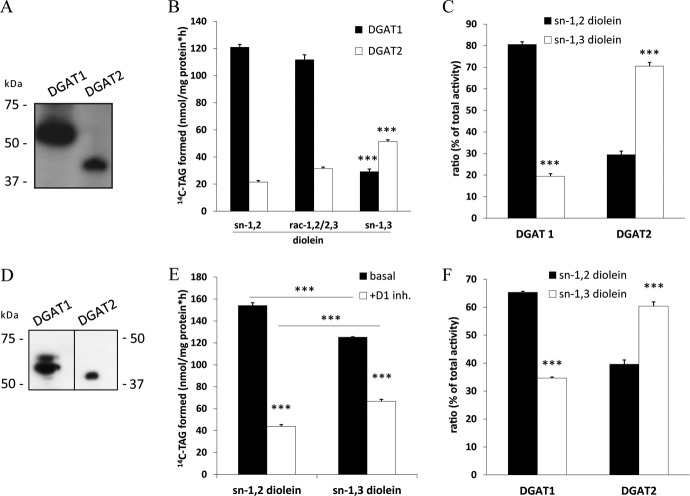FIGURE 7.
DGAT1 and DGAT2 exhibit different preferences for DAG regioisomers. A, expression of FLAG-tagged murine DGAT1 and DGAT2 in Cos-7 cells was assessed by immunoblotting. B, lysates of Cos-7 cells expressing FLAG-tagged DGAT1 or DGAT2 were incubated with either sn-1,2, rac-1,2/2,3, or sn-1,3 diolein substrate emulsified with phospholipids and 14C-labeled oleoyl-CoA at 37 °C for 10 min. Lipids were extracted and separated by TLC, and radioactivity in the TAG bands was determined by scintillation counting. C, regioselectivity of recombinant DGAT enzymes against sn-1,2 or sn-1,3 diolein is expressed as a percentage of total acyltransferase activity. D, endogenous expression of DGAT1 and DGAT2 in WAT was determined by immunoblotting using anti-DGAT1 and anti-DGAT2 antibody. E, microsomal fractions of WAT from fed C57Bl/6-mice were assayed for DGAT activity in the presence and absence of a specific DGAT1 inhibitor (D1 inh., 2-((1s,4s)-4-(4-(4-amino-7,7-dimethyl-7H-pyrimido[4,5-b][1,4]oxazin-6-yl)phenyl)cyclohexyl)acetic acid) using sn-1,2 or sn-1,3 diolein as substrate as described in A. F, regioselectivity of endogenous DGATs in WAT expressed as a percentage of total acyltransferase activity is shown. Data are normalized to LacZ and presented as means ± S.D. and are representative of two independent experiments (***, p < 0.001).

